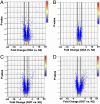Dynamic O-GlcNAc cycling at promoters of Caenorhabditis elegans genes regulating longevity, stress, and immunity
- PMID: 20368426
- PMCID: PMC2867743
- DOI: 10.1073/pnas.0911857107
Dynamic O-GlcNAc cycling at promoters of Caenorhabditis elegans genes regulating longevity, stress, and immunity
Abstract
Nutrient-driven O-GlcNAcylation of key components of the transcription machinery may epigenetically modulate gene expression in metazoans. The global effects of GlcNAcylation on transcription can be addressed directly in C. elegans because knockouts of the O-GlcNAc cycling enzymes are viable and fertile. Using anti-O-GlcNAc ChIP-on-chip whole-genome tiling arrays on wild-type and mutant strains, we detected over 800 promoters where O-GlcNAc cycling occurs, including microRNA loci and multigene operons. Intriguingly, O-GlcNAc-marked promoters are biased toward genes associated with PIP3 signaling, hexosamine biosynthesis, and lipid/carbohydrate metabolism. These marked genes are linked to insulin-like signaling, metabolism, aging, stress, and pathogen-response pathways in C. elegans. Whole-genome transcriptional profiling of the O-GlcNAc cycling mutants confirmed dramatic deregulation of genes in these key pathways. As predicted, the O-GlcNAc cycling mutants show altered lifespan and UV stress susceptibility phenotypes. We propose that O-GlcNAc cycling at promoters participates in a molecular program impacting nutrient-responsive pathways in C. elegans, including stress, pathogen response, and adult lifespan. The observed impact of O-GlcNAc cycling on both signaling and transcription in C. elegans has important implications for human diseases of aging, including diabetes and neurodegeneration.
Conflict of interest statement
The authors declare no conflict of interest.
Figures




References
-
- Hart GW, Housley MP, Slawson C. Cycling of O-linked beta-N-acetylglucosamine on nucleocytoplasmic proteins. Nature. 2007;446:1017–1022. - PubMed
-
- Hanover JA. Glycan-dependent signaling: O-linked N-acetylglucosamine. FASEB J. 2001;15:1865–1876. - PubMed
-
- Love DC, Hanover JA. The hexosamine signaling pathway: Deciphering the “O-GlcNAc code”. Sci STKE. 2005;2005:re13. - PubMed
Publication types
MeSH terms
Substances
Associated data
- Actions
Grants and funding
LinkOut - more resources
Full Text Sources
Other Literature Sources
Molecular Biology Databases
Research Materials

